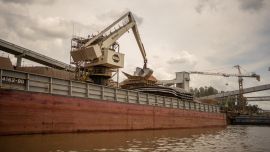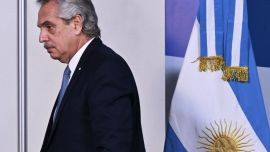If the aim of this column is to give current events the perspective of 34 years of newsroom experience at the Buenos Aires Herald (1983-2017), few keywords have been more constant throughout that experience than “crisis.” If people find the current pace of inflation and the shrinking peso alarming (as indeed they should), my starting salary for my first full month at the Herald in the June of 1983 was three million pesos (then worth around US$70). Annual inflation during the 1983-1989 Raúl Alfonsín presidency averaged almost 600 percent when this year any decisive lurch into three digits still lies ahead but until the last few months of hyperinflation those levels seemed almost normal with most people used to a heavily index-linked plateau of a monthly 20 to 25 percent.
To be fair, the problems I started observing as from 1983 had already been precooked by the military dictatorship – the deindustrialisation from the discontinuation of import substitution without advancing any alternative model, a banking system with confidence based on deposit guarantees unbacked by concrete reserve requirements, the collapse of that confidence in a context of crumbling military rule accelerated by military defeat and the disastrous bid of youthful 1982 Central Bank governor Domingo Cavallo to restore confidence by nationalising private foreign debt (taking total foreign debt up to US$45 billion from US$8 billion in 1976 – a similar figure to that much reviled International Monetary Fund standby in times when a dollar was worth a lot more). Nor did the global context help, any more than today amid the fallout from the Russian invasion of Ukraine, with the 1982 Mexican debt crisis.
While not primarily responsible for the problems, the Radicals did not do much to solve them either beyond the imaginative and initially successful Austral Plan of 1985, letting things slide into the 1989 hyperinflation. Taking office amid monthly, not annual three-digit inflation, Carlos Menem did not immediately find his feet but trends both at home and abroad worked in favour of a neo-liberal economic course – hyperinflation made most people allergic to populism here while the fall of the Berlin Wall at the end of a decade dominated by Ronald Reagan and Margaret Thatcher in the English-speaking world and Deng Xiaoping in China was taking the world in a very different direction later known as the Washington Consensus. Convertibility in 1991 is generally regarded as the heart of Menem’s policies but privatisation, deregulation and state reform were all underway well beforehand. This abrupt interruption of inflation was followed by half a decade of growth, accompanied by capital entry and an export boom with both infrastructure and agricultural technology impressively modernised, but again trends both at home and abroad conspired against a happy ending to the century – Menem’s fiscal laxity in pursuit of a third term left the country vulnerable to such overseas turbulence as Mexico’s tequila crisis of 1994-1995, the Russian flu of 1998 and finally Brazil’s maxi-devaluation in early 1999.
By the turn of the century convertibility had become an empty shell with the peso no longer seen as interchangeable with the dollar. The 2001-2002 financial and economic meltdown began with the corralito bank deposit freeze in response to a run on the banks, followed by the rapid collapse of the Alliance government – by 2002 the economy had shrunk by over 20 percent from 1998 with 57 percent of the population below the poverty line. But wiping out savings in the form of an asymmetrical pesofication of pegging dollar deposits at 1.40 pesos, when the greenback was quoting at three or four pesos, also had the effect of wiping out debts and the country made a fresh start with Argentina boasting one of the world’s highest growth rates through to the international subprime crisis of 2008, aided by exports more than doubling in that period amid a global commodity boom.
The global financial crisis of 2008-2009 made itself felt locally in Argentina but was followed by the Bicentenary and re-election splurges of 2010 and 2011, fed in part by the confiscation of private pension funds compensating for the failure to hike export duties and by the debt bond swap of 2010. But crisis soon returned with the 2013-2014 recession while the running battle with the so-called ‘vulture funds’ spiralled into default in 2014 with the biggest devaluation in a decade early that year. Mauricio Macri’s victory in 2015 reshuffled various cards but the wheels starting coming off in the drought year of 2018, driving him to that IMF stand-by package of US$57 billion until his 2019 PASO primary debacle anticipated the discontinuation of his policies – the peso lost half its value in days. And so from that crisis to now at the other end of the coronavirus pandemic.
In short, no decade of Argentine history is complete without an economic crisis with negative growth every four years on average. What is unique about this crisis is that it has so far been accompanied by growth, if for perverse reasons – people cannot spend their pesos fast enough with inflation fed by velocity of circulation even more than excess of issuance while industrial production enjoyed a full set of artificially cheap imports until this week’s restrictions. But we are only just starting.


















Comments